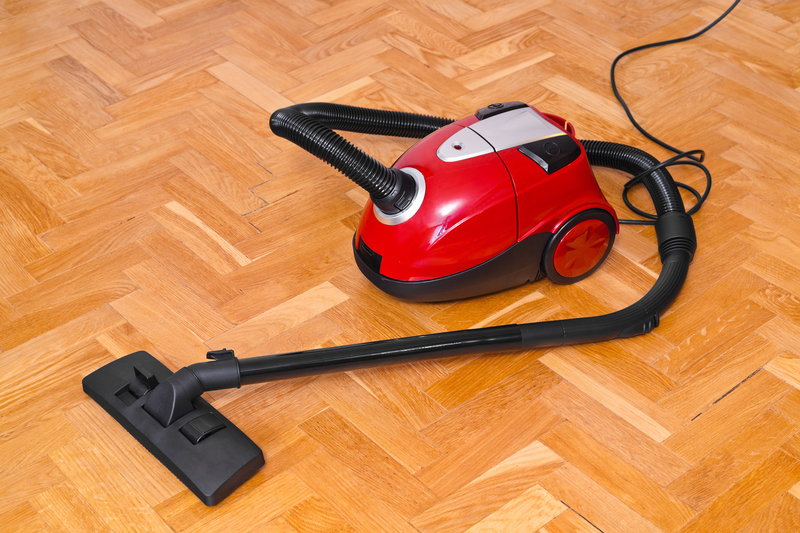Transform Your Space with Optimal Air Quality
Posted on 03/09/2025
Transform Your Space with Optimal Air Quality: The Comprehensive Guide
In today's fast-paced world, our indoor environments matter more than ever. While we may focus on aesthetics, furniture, and decor, one crucial aspect often gets overlooked: air quality. Learning how to transform your space with optimal air quality can impact your health, productivity, and overall quality of life.

Why Air Quality Matters in Your Living and Work Spaces
*Optimal indoor air quality* goes beyond simply breathing "fresh air." It's about cultivating an environment free of allergens, pollutants, and toxins. Poor air quality can cause or exacerbate several health issues, including allergies, asthma, fatigue, and even cognitive difficulties. Whether at home, in the office, or in shared spaces, understanding and improving air quality is central to creating a healthy, comfortable atmosphere.
The Impact of Suboptimal Air on Health and Well-being
- Respiratory Issues: Dust, pet dander, and airborne chemicals commonly found indoors can trigger or worsen respiratory problems.
- Reduced Productivity: Polluted indoor air has been linked to decreased focus and lower productivity, especially in workspaces.
- Increased Allergies: Without proper filtration and ventilation, allergens accumulate, causing ongoing discomfort.
- Headaches and Fatigue: Exposure to molds or volatile organic compounds (VOCs) can lead to persistent headaches and tiredness.
- Long-Term Health Risks: Continuous exposure to indoor pollutants may elevate the risk of more severe conditions, including cardiovascular disease and cancer.
Key Contributors to Indoor Air Pollution
Understanding what diminishes your indoor air quality is the first step to transformative change. Here are some of the main offenders:
- Outdoor pollutants: Smoke, pollen, and dust often infiltrate through windows and doors.
- Household chemicals: Cleaning products, paints, and even perfumes emit VOCs that linger in the air.
- Building materials: Some carpets, furnishings, and wall paints release formaldehyde and other harmful gases.
- Poor ventilation: Spaces with inadequate airflow allow pollutants to build up, often undetected.
- Appliance emissions: Gas stoves, heaters, and fireplaces can release carbon monoxide and nitrogen dioxide.
- Mold and mildew: High humidity fosters the growth of these irritants, which can hide in walls, ceilings, and HVAC systems.
How to Transform Your Space for Optimal Air Quality
Creating a sanctuary of clean, fresh air doesn't require a complete structural overhaul. By understanding and applying best practices, you can radically improve your indoor environment.
1. Ventilation: The Foundation of Clean Air
- Open Windows and Doors: Whenever possible, create a cross-breeze to flush out stale air.
- Mechanical Ventilation: Use exhaust fans in kitchens and bathrooms to remove humidity and airborne contaminants.
- Air Exchangers: Consider investing in energy-recovery ventilators (ERVs) or heat-recovery ventilators (HRVs), especially in modern airtight homes.
Proper ventilation is fundamental to achieving optimal air quality. Not only does it dilute indoor pollutants, but it also brings in much-needed oxygen.
2. Air Purification Solutions
- HEPA Air Purifiers: HEPA filters trap microscopic particles such as pollen, dust mites, and pet dander, significantly cleaning your space's air.
- Activated Carbon Filters: These are highly effective at removing odors and volatile organic compounds.
- UV Air Purifiers: Utilize ultraviolet light to neutralize bacteria, viruses, and molds in the air.
- Ionic and Electrostatic Air Cleaners: These devices charge airborne particles causing them to stick to collection plates or surfaces, removing them from circulation.
Choose an air purifier suited to your room size and the specific contaminants you wish to target. Pairing different technologies can deliver cleaner, purer air.
3. Humidity Control
- Dehumidifiers: In damp climates, these devices keep relative humidity between 30-50%, a range that discourages mold and mildew.
- Humidifiers: During winter or in arid areas, humidifiers prevent dryness that leads to itchy skin and respiratory irritation.
- Regular Monitoring: Invest in a quality hygrometer to monitor moisture levels, adjusting as needed.
Balanced humidity equals healthier air--it makes your environment more comfortable and less hospitable to allergens.
4. Houseplants: Nature's Air Purifiers
- NASA's Clean Air Study: Revealed that certain houseplants--such as spider plants, peace lilies, and snake plants--not only produce oxygen but can also remove harmful toxins.
- Placement: Distribute plants throughout your space for maximum benefit. Remember to care for them to prevent moldy soil.
- Allergy considerations: Choose low-pollen varieties if you or anyone in your space struggles with allergies.
Plants are an attractive, sustainable way to enhance air quality and add a touch of natural beauty.
5. Regular Cleaning Practices
- Vacuum with HEPA Filters: HEPA vacuums prevent dust and allergens from recirculating into the air.
- Wash Fabrics Frequently: Curtains, bedding, and upholstery collect dust, pollen, and pet hair.
- Avoid Harsh Chemicals: Opt for natural or eco-friendly cleaning products to minimize airborne irritants.
- Control Clutter: Fewer surfaces mean dust has less space to accumulate, making cleaning easier and more effective.
Routine cleaning disrupts the cycle of dust, bacteria, and allergens before they impact your wellness.
6. Address Sources of Pollution
- Avoid indoor smoking: Tobacco smoke releases thousands of harmful substances.
- Properly seal storage: Paints, solvents, and other chemicals should be stored away from living environments, ideally outside or in sealed containers.
- Upgrade appliances: Modern stoves, heaters, and fireplaces are designed for more efficient combustion, reducing toxic byproducts.
- Improve lighting: Use LED lights, which do not emit heat or volatile substances, enhancing your overall indoor quality.
Proactively eliminating pollution at its source is the most reliable way to sustain optimal air quality long-term.
Optimal Air Quality for Different Spaces
Every environment has unique requirements. Let's look at how to optimize air quality in several typical settings:
Living Rooms and Bedrooms
- Regularly ventilate rooms--open windows and doors daily, even for a short period.
- Invest in bedroom-specific air purifiers, where clean air impacts sleep quality and restfulness.
- Choose hypoallergenic bedding to further limit allergen exposure.
Kitchens
- Use range hoods: A functioning hood with exterior venting can eliminate cooking odors, smoke, and moisture efficiently.
- Check gas appliances: Test regularly for leaks and ensure good combustion to prevent carbon monoxide buildup.
Bathrooms
- Install exhaust fans: Reduce humidity to discourage mold growth.
- Dry surfaces promptly and clean tile grout to prevent mildew and bacteria colonies.
Workspaces and Home Offices
- Ventilate often or use portable air purifiers.
- Declutter work areas to minimize dust collection.
- Consider using natural plants to reduce stress and remove VOCs.
How to Maintain Optimal Air Quality All Year-Round
Regular maintenance and observation are crucial to transforming and preserving your indoor air. Here are ongoing strategies for lasting air quality:
- Change air filters seasonally: Whether in HVAC units or standalone purifiers, swap out filters to ensure efficiency and air cleanliness.
- Schedule professional HVAC checkups: Annual expert inspections can catch hidden problems like duct leaks or mold buildup.
- Seal cracks & gaps: Ensure your space is weatherproofed to block dust, pollen, and insects from entering uninvited.
- Test for radon and carbon monoxide: Both are invisible, odorless threats that require specialized detectors.
- Monitor indoor air quality: Invest in smart air quality monitors to track particulate levels, humidity, temperature, and VOCs in real time.
Benefits of Transforming Your Space with Clean, Optimal Air
- Enhanced Health: Reduced risk of allergies, asthma, and respiratory infections.
- Greater Comfort: Say goodbye to musty smells, persistent dust, and airborne irritants.
- Sustainable Wellness: Long-term improvements in sleep quality, energy levels, and overall well-being.
- Boosted Productivity: Clean air fosters greater focus and mental clarity in work or study environments.
- Increased Property Value: A healthy indoor environment is a top feature for modern homebuyers.
Common Myths About Indoor Air Quality
- "Indoor air is always cleaner than outdoor air."
- In reality, indoor air can be 2 to 5 times more polluted due to poor ventilation and chemical emissions.
- "If it doesn't smell bad, it must be clean."
- Many harmful pollutants--including carbon monoxide and radon--are colorless and odorless.
- "Houseplants alone can purify your space."
- While beneficial, plants should complement--not replace--other air quality measures.
- "You only need to worry if someone has allergies."
- Poor air can impact cognition, energy levels, and long-term health for everyone, not just allergy sufferers.

The Future of Healthy, Transformative Indoor Spaces
With evolving technology and deeper awareness, optimizing your air quality is becoming easier, more effective, and more affordable. Smart devices can now automate everything from filtration to humidity control, while emerging sustainable construction materials emit fewer toxins.
Building your ideal environment isn't just an aesthetic journey--it's a health investment that pays dividends. By applying even a few of these strategies, you'll immediately experience a more vibrant, comfortable, and invigorating space every day.
Your Journey to Optimal Air Quality Starts Now
Transforming your space with optimal air quality starts with informed choices and consistent action. Embrace ventilation, purification, and prevention to breathe easier, feel better, and create an environment you truly love. Begin now, and let every breath you take be a step toward a healthier future.
Remember: The journey to transforming your space with the best air quality is ongoing. Start today and discover the profound difference optimal air makes in your life!




